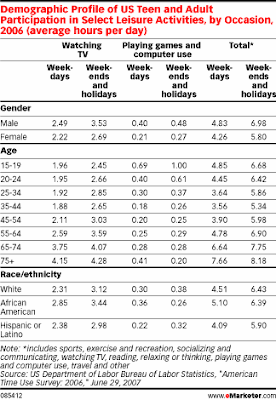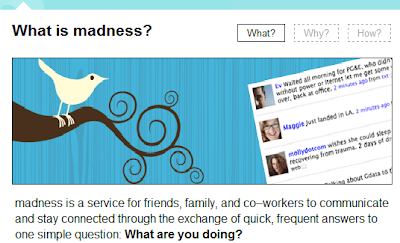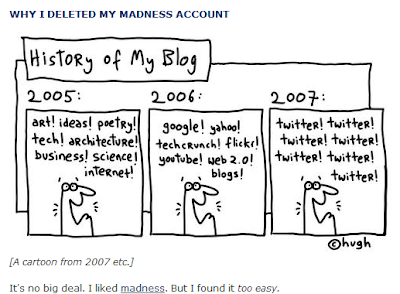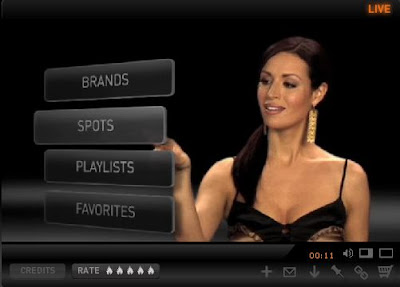100 Million Hours of Ads a Weekend?
Posted in: UncategorizedYou might have already seen Clay Shirky’s now famous speech about cognitive surplus given at Web2Expo and the dramatic comparison of the time spent watching TV (200B hours a year in the US) and building Wikipedia (100M hours total).
He mentioned another number I thought was interesting: “In the US, we spend 100 million hours a weekend watching just the ads” (fast-forward to 5:52, or read the transcript). The order of magnitude seems right but I can’t figure out how he arrived at his estimate. Here are the inputs I’m working with.
– Number of hours spent by men watching TV on weekends: 6.98hrs (less for women, but I’m keeping the math simple). I don’t know if the number is an average across the entire population or only accounts for those who watch TV.
– Number of ad minutes per hour of TV programming: 16 (wiki), which means 3.72 hours of ads total for a two-day weekend (16*6.98/60*2).
Now, to arrive at the 100M hours number, we need to assume an active audience of 26,881,720 (100M/3.72hrs) viewers on each of the two days. How accurate is this number? I’ll try to check with our media folks next week, but drop a comment if you have ideas.
Of course, this little calculation assumes that Shirky’s remark was not a mere rhetorical device (hey, if we just stopped watching ads we could build a wikipedia in a weekend) and that people do watch all of the ads throughout the entire 7-hour TV binge instead of doing laundry or zoning out.
Related:
Dissecting Advertising Clutter
The Ad Zapper in Your Brains
Block Twitter Madness Out of Your Life
Posted in: UncategorizedLet me start by acknowledging that Twitter looks useful. I remain one of those who don’t get it (I tried), but there are many other things I don’t quite understand and in most cases my ignorance is due to my own limitations.
So, Twitter, it’s not you, it’s me. A few things have been bugging me about you ever since we met — readers are not sheep to be called followers — but really, you are cool. We’ll remain polite to each other even if entrenched in our respective worldviews. Who knows, maybe we’ll do business together one day.
What I can’t explain — nor calmly bear — is the nauseating giddiness that’s been bubbling in my RSS reader for the past year. Everywhere I clicked, it’s been twitter this, twitter that. High-school dramas over who tweeted what to whom. (Speaking of 2.0 dramas, here’s a great collection.) It was amusing for a couple of months, after which I hoped the spotlight would turn away. It never did, so I thought I’d do something about it myself. Now, everywhere I browse, the words “twitter” and its derivatives are replaced with what the whole thing really is – “madness”. All it took was a Greasemonkey Firefox extension and a slightly tweaked profanity filter.
It’s like one moment you have hundreds of canaries in your room, and then suddenly someone turns them all off.
It’s quieter, and everything makes a lot more sense, too.
The followers of GapingVoid’s author mourned his departure from madness in some 150 comments.
Assorted April Media Hoaxes
Posted in: UncategorizedThis year’s ad prank is Trust Banners that gain “consumer trust through high frequency (90fps) banner adverts which stimulate specific regions of the visual cortex (Visual area V5/MT) producing instant effects on consumers.”
Turning black and white TVs into color sets by wrapping them in nylon stockings must be the best media-related April 1 hoax ever (Orson Welles’s War of the Worlds was on Halloween so it doesn’t qualify). Above is the original broadcast on the Swedish TV back from April 1, 1962.
Among the pranks that would actually make sense to implement for real is last year’s announcement by XM radio that it is launching a new channel entirely powered by podcasts.
The always adorable Google added a new function to Docs this year that creates a blank document with an outline of a paper airplane.
Also:
Remote Control Jammer Chip Activated By Commercials
Spam Through Google Calendar
Posted in: UncategorizedIdea: Remote Control Jammer Chip Activated By Commercials
Posted in: UncategorizedImagine this. You send out a bunch of promo stuff: schwag, catalogs, merchandise. Every item is equipped with a small chip. Next, you create a TV commercial and insert an “inaudible 200MHz molecular vibration sound mat”. When you run the spot on TV, the inaudible signal activates the chip, which in turn jams the signal from your remote control blocking people from switching channels. When your commercial stops playing, the remote goes back to normal.
Welcome The XV2083 Remote Control Jammer. The video is below.
Too bad it ain’t a real product, but a campaign by a communications agency. Very convincing, though. The next version of the chip should also emit signals that block microwave ovens and suppress bathroom urges.
It’s not entirely science fiction, though. Here’s a video of a working TV remote jammer and instructions for building one, and a diagram:
A World Without Billboards
Posted in: UncategorizedAbove: an ad for Sky movies (“you don’t like interruptions so we took out the ads”) showing a world without billboards.
Below: a slideshow of Sao Paolo after the mayoral billboard ban.
Firebrand Ratings: How Many People Watch One Hour of TV Commercials
Posted in: UncategorizedQuick intro: Firebrand is a one-hour 11pm weeknights TV show on ION that has nothing but commercials. The show has a website. The idea is that “viewers will gladly watch commercials” if they are entertaining and non-intrusive.
AdRants did a post on Firebrand a few days ago, saying, “We’re pretty sure the only people watching Firebrand this week or any week will be people working in advertising, hardly an audience large enough to support the company’s grandiose vision of becoming some sort of popular destination. “
Shari Leventhal, Firebrand’s CEO, responded (fourth comment after the post on AdRants): “We’ve had over 2.5 million viewers watching Firebrand on average each week.”
Curious, I checked the numbers:
- Number of people watching Firebrand TV show on ION (11 pm weeknights): 106,000*
- Number of people employed in advertising agencies in the US: 188,100**
Am I doing the math wrong? Is Nielsen off?
Below is the website traffic estimate (uniques) from Compete.com:
* Nielsen’s ratings for Jan 1-31 2008 for Firebrand: 0.09 HH (106,000 average nightly viewers), 0.06 AD2554 (75,000 adult viewers 25-54)
** US Bureau of Labor Statistics, Nov 2007 estimate, full chart pulled from this page.
Ad Skipping Strains Power Grid
Posted in: Uncategorized
“The 1990 World Cup tops the list of record-breaking TV “pick-ups” (Source: National Grid, BBC)”
Even though the Superbowl Flush is a myth and our American readers have nothing to fear this coming Sunday, it doesn’t mean that the collective ad avoidance doesn’t strain urban infrastructure elsewhere. Virtual Economics unearthed a decade-old article from BBC about Brits leaving their TVs during the World Cup half-time to — what else? — make some tea:
“This mass synchronised tea-break has in the past caused huge power surges and problems for the National Grid, which operates the high-voltage transmission network in England and Wales.
A crack team of statisticians with their finger on the pulse of the TV sub-culture leaf through listings magazines in an attempt to predict peaks in electricity use.”
Dissecting Advertising Clutter, Part II
Posted in: UncategorizedLast November, I spent some time poking around and trying to figure out where the “an average American is exposed to 5000 ad messages” number had come from (see the original post). President of Yankelovich J. Walker Smith, whom I cited as one of the sources, offered his explanation in a comment to the post on Hill Holliday blog:
“Still, it’s interesting to know how these ad exposure estimates are calculated. The oldest such estimate is the one cited by David Shenk in Data Smog. His figure comes from a figure cited in Alvin Toffler’s 1971 book Future Shock. Toffler’s figure came from a conference speech that cited a number calculated by Bill Moran for use in that speech (delivered by his boss) when he was running the research function at Y&R. I know this because I am a friend of Bill’s and he has related this story to me. Bill made a simple calculation. He simply conducted a thought exercise and went through the typical day for a typical person in a typical American big city in the 1960s. How many times would such a person be exposed to some sort of ad, logo or promotion? He came to around 500. It’s that simple, and that’s where this early figure comes from.
Note what is being calculated here. Not the number of ads people pay attention to, but the number of ads that people might pay attention to. It’s exposure opportunities. Obviously, we live lives nowadays in which ever more of the white space around us is crowded with ads. Thus, we have many more opportunities for ad exposure.”
Earlier:
Dissecting Advertising Clutter, Part I
Advertising Clutter in 1759
The Ad Zapper in Your Brains
Posted in: UncategorizedDuring commercial breaks,
- 41.2% of viewers channel-surf
- 33.5% talk with others in the room or by phone
- 30.2% mentally tune out
- 5.5% regularly fully attend to commercials
In other news, this winter fewer people eat (68.8%) and more people do laundry (58%) while consuming media (70% and 57.4% in July 2007, respectively). This and other amusing tidbits in the new BIGresearch’s research of simultaneous media consumption SIMM 11.










